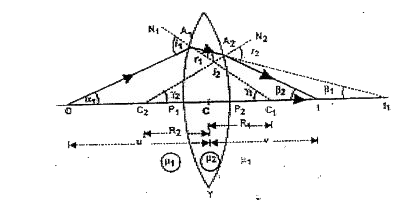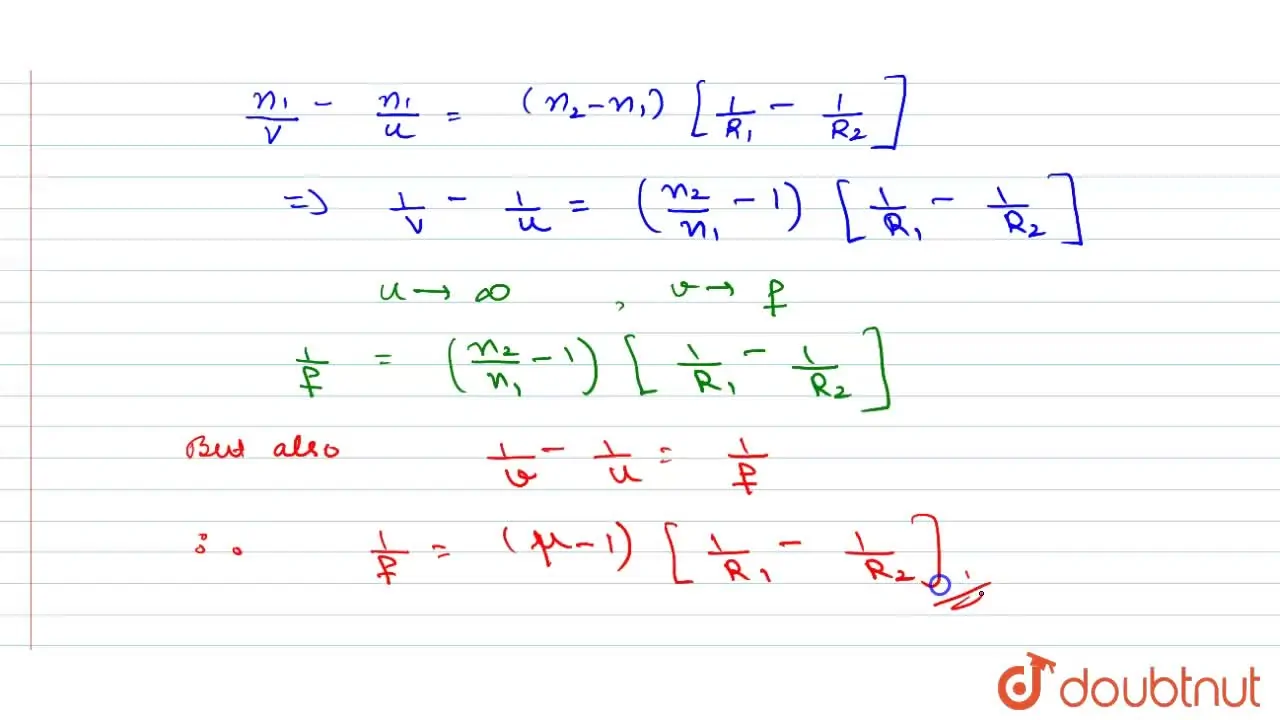With the help of suitable diagram, sign conventions and assumptions, derive lens Maker's formula for a convex lens.Solution in Punjabi
Lens maker.s formula, A formula which relates the focal length of a lns, refractive index of the material of the lens and radii of curvature of two refracting spherical surfaces is known as lens maker.s formula.
The lens manufacturers use this formula to design lens of required focal lengh and that is why it is known as lens maker.s formula.
Assumptions:
Consider a convex lens made of a material of refractive index μ2 the and placed in optically rarer medium of absolute refractive index μ1. Let P1 and P2 be the poles: C1 and C2 the centres of curvature and R1 and R2 the radii of curvature of the two surfaces XP1Y and XP2Y of the lens respectively. Let C be the optical centre of the lens.

Suppose that O is a point object placed on the principal axis of the lens. The surface XP1Y and forms the real image I1 (assuming that material of the lens extends beyond the face XP1Y as such). It can be obtained that
μ1P1I+μ2P1I1=μ1−μ1P1C1 ..........i
Since lens is thin the point P1 lies very close to the optical centre C of the lens.Therefore, we may write
P1O≈CO,P1I1≈CI1 and P1C1≈CC1
Therefore eqn (i) becomes
μ1CO+μ2CI1μ2−μ1CC1........i
Let us now consider refraction from the other surfacse XP2Y of the convex lens. Actually, material of lens does not extend beyond the surfacd XP2Y. Therefore before the refracted ray from point A1 could meet the principal axis, it will suffer refraction at the point A2 on the second surface XP2Y and the ray of light will actually come to meet the principal at the point I. Thus, point I may be considered as the real image of the virtual object I1 (placed in the material of the lens) is formed due to refraction from the surface XP2Y of the lens. It can be deduced that
−μ2P2I1+μ1P2I=μ2−μ1P2C2..........iii
Again as the lens is thin we may write
P2I1≈CI1,P2I≈CI and P2C2≈CC2
Therefore the equation iii may be written as
−μ2CI1+μ1CI=μ2−μ1CC2.....iv
Adding the equations ii and iv we have
μ1CO+μ2CI1−μ2CI1+μ1CI=μ2−μ1CC1+μ2−μ1CC2
or μ1CO+μ1CI=(μ2−μ1)(1CC1+1CC2).......v
Applying new cartesian sign conventions
CO=−u
CI=+v
CC1=+R1
and CC2=−R2
There eqn (v) becomes
μ1−u+μ1+v=(μ2−μ1)(1+R1+1−R2)
or μ1u+μ1v=(μ2−μ1)(1R1−1R2)
Dividing both sides of the above eqn by μ1 we have
−1u+1v=(μ2μ1−1)(1R1−1R2)
Since μ2μ1=μ we have
−1u+1v=(μ−1)(1R1−1R2)
Related Playlists
- BOOK - BETTER CHOICE PUBLICATIONCHAPTER - REFRACTION OF LIGHTEXERCISE - NUMERICAL PROBLEMS36videos
REFRACTION OF LIGHT
- BOOK - BETTER CHOICE PUBLICATIONCHAPTER - REFRACTION OF LIGHTEXERCISE - SHORT ANSWER TYPE QUESTIONS19videos
REFRACTION OF LIGHT
- BOOK - BETTER CHOICE PUBLICATIONCHAPTER - REFLECTION OF LIGHT EXERCISE - NUMERICALS PROBLEMS7videos
REFLECTION OF LIGHT
- BOOK - BETTER CHOICE PUBLICATIONCHAPTER - SEMI CONDUCTOR DEVICESEXERCISE - Most Expected Questions6videos
SEMI CONDUCTOR DEVICES
Similar Questions
A convex lens of refractive index 1.5 has a focal length of 18 cm in air.Calculate the change in focal length,when it is immersed in water of refractive index 4/3.
05:59View SolutionWhat is meant by power of a lens? What does its sign indicate? State it SI unit, how is it related to the focal length of a lens?
07:16View SolutionA 5 cm long needle lies along the principal axis axis of a concave miror of focal length 20 cm in such a way that the end closer to the pole is 40 cm from it.Find the length of the image of the needle formed by the mirror.
07:16View SolutionCan two P-N junction diodes back to back works as P-N-P transistor?
07:16View SolutionDerive lens maker's formula for a thin convex lens.
07:16View SolutionDerive th lens maker's formula.
View SolutionDerive th lens maker's formula.
07:16View SolutionDerive th lens maker's formula.
03:21View SolutionDerive th lens maker's formula.
05:45View SolutionDerive lens maker's formula for a thin biconvex lens.
07:06View SolutionDerive th lens maker's formula.
View SolutionWith the help of suitable diagram, sign conventions and assumptions, derive lens Maker's formula for a convex lens.
08:19View SolutionBy giving assumptions made, derive the lens maker formula for a double convex lens.
07:40View SolutionBy stating assumptions made and sign conventions used, derive mirror formula in case of convex mirror with the help of labelled ray diagram.
01:51View SolutionDerive lens maker's formula for a biconvex lens.
10:24View SolutionWrite down lens maker's formula for a convex lens.
05:12View Solution


